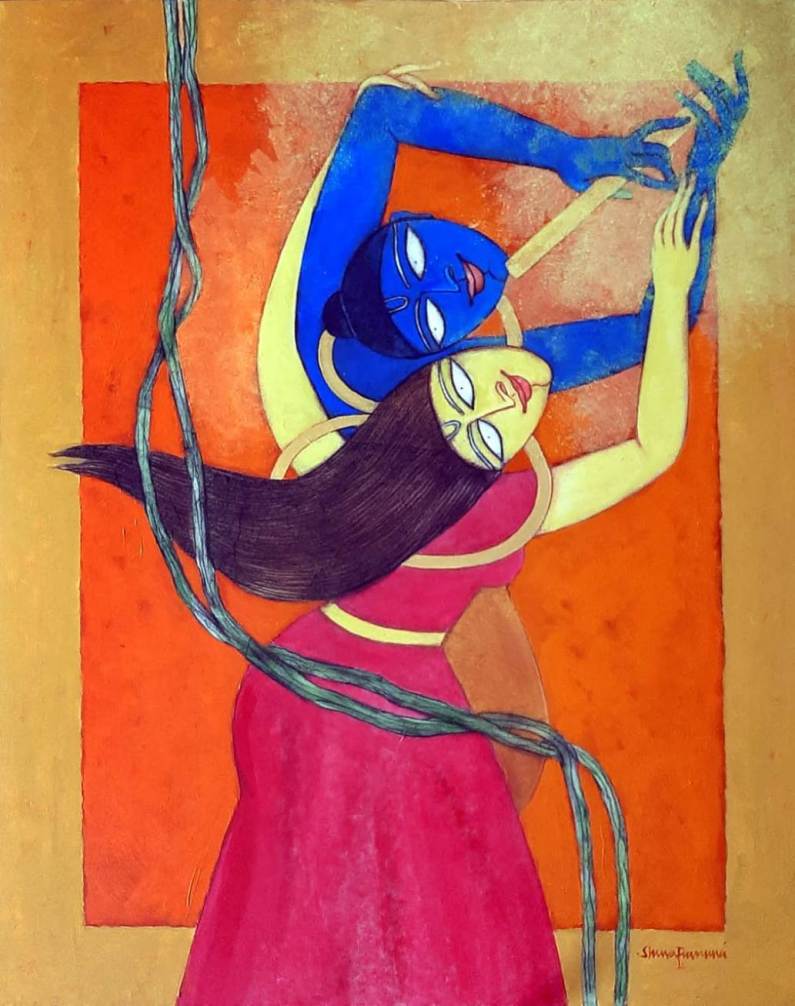One of the most popular series of the Master Artist, The Golden Flute is the artists more romantic renedition of Art. The iconic figures of Krishna, Radha, and Ganesha that found lyrical expression in the Icons series are modern representations and sophisticated idealizations of the same images in the popular media.
Krishna is a cosmic musician, and the tune he creates by playing his transcendental flute is embodied with cosmic energy. When Krishna is depicted as being between the age of 5 and 8, it is always with his flute. Therefore, during this period, he is aptly called Murlidhara (murali means “flute,” and dhara means “hold”), signifying the one who holds the flute. He is never without it, whether he is with his mother, on the grazing grounds with his herd of cows, among his cowherd companions or roaming around on the Jamuna banks. Gopis lose their selves in this tune. For them, music becomes the voice of love, which is too passionate and secretive.
The Golden Flute is one of the most popular series by the artist . The simple Radha Kishen togetherness and iconography is brought forth in a different way to the viewer .
Consider his Krishna. It is not difficult to see what the sources of his image are, but those are primarily in the area of iconography. The Lord is rendered naturally in blue, dark as a cloud, like he is in countless paintings from the past, whether Rajasthani or Pahari. The tilak or the Urdhva Pundra beautifully adorns his forehead. What he holds in his hand is no weapon or Ayudha ( adornment ) , but the bansuri ( The flute). The Brilliant yellow garment or the pita vastra wraps around the lord’s hips, its brightness glistening against his dark skin.
He is surrounded by peacocks, with the feather of which he decorates his crown .
Shuvaprasanna captures all this and brings forth an unearthly air with these constructs and abstractions. The remarkable thing, however, is that the imagery brings forth no loss of feeling or reverence for the iconic imagery of lord Krishna .
It is a different kind of Lila that Shuvaprasanna invites the viewers to witness.
He doesn’t merely portray reality as ‘matter of fact’ and his presentation of reality often has dream-like elements in it. In terms of technique, Shuvaprasanna boasts a precise, finely executed style that yields an unmistakable visual intensity. He works comfortably in an assortment of media, including oil on canvas, charcoal, and mixed media.
About the Artist and his work :
Born : In Calcutta, 1947.
Education :
Graduated from Indian College of Art (R.B. University, Calcutta) in 1969.
Exhibitions :
Shuvaprasanna has had several gallery and museum exhibitions, including at the Tao Art Gallery and at the Chawla Art Gallery, Square One Mall. Several works by the artist have been sold at auction, including ‘ABODE’ sold at Waddington’s ‘Fine Prints & Photography Auction’ in 2014. There have been many articles about Shuvaprasanna, including ‘An exclusive edifice’ written by Kunal Ray for The Hindu in 2014.
Selected Solo Exhibitions :
2011 – Shuvaprasanna: Recent Works, CIMA, Centre of International Modern Art, India, Kolkata
2010 – Summer Show 2010, CIMA, Centre of International Modern Art, India, Kolkata
2007 – ‘Madhura: The Golden Flute’, organized by Indian Contemporary at Visual Arts Centre, Hong Kong
2006 – ‘The Divine Flute’, Aicon Gallery, USA
2002 – ‘Icons and Illusions’, Gallery ArtsIndia, New York
1998 – ‘An Appreciation of Ted Hughes’, Exhibition of Crow Paintings, British Council, Kolkata
1975 – Gallery Atlantis, Aix-En-Provence, France
1974 – Gallery “Les Hirondelles” Geneva, Switzerland
Selected Group Exhibitions
2016 – Gallery Collection January 2016, Tao Art Gallery, India, Mumbai
2015 – The Ecstasy of Art – 1, Tao Art Gallery, India, Mumbai Vibgyor: Canvases and Sculptures, Chawla Art Gallery, Square One Mall, India, New Delhi
2014 – Infinite: Tao’s 14th Anniversary Show, Tao Art Gallery, India, Mumbai
2012 – 1/25, Bengal Gallery of Fine Arts, Bangladesh, Dhaka
Joint Exhibitions :
1997 – With Shipra Bhattacharya, Art Today, New Delhi
Honours and Awards :
1979 Awarded by All India Fine Arts and Crafts Society (AIFACS), New Delhi
1978 Awarded by State Lalit Kala Academy, West Bengal
1977 Awarded by Birla Academy of Art and Culture, Kolkata.











